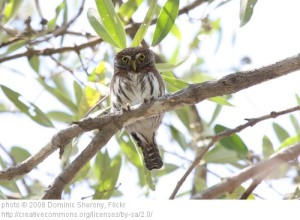In my last post, I catalogued a variety of issues facing owls in different places around the world- while a lot of that was focused on the northern spotted owl, the issue of habitat loss is pretty well universal. I had expected that most of the recent literature on owl conservation would investigate complex relationships between prey species and predator numbers or assess the success of different conservation programs, but a lot of what I found was mainly about diet or habitat selection, which suggests to me that we still have some large gaps in our ecological knowledge of many owl species (there were also many papers recounting the westward spread of barred owls as scientists compared theories for the cause- after a while, it felt like I was reading the same thing over and over…).
The good news is that there were some signs that conservation efforts and general awareness of ecological relationships have given some owl species the space they need to recover or remain stable. An assessment of owl species across Europe found that only 4 of 15 species had declined between 1990 and 2000, perhaps in part because 8 of the owl species have action plans to facilitate conservation (Burfield 2008). Further research into the distribution and habitat needs of the cloud-forest screech owl (Megascops marshalli) suggests that a larger population exists over a larger range than had previously been thought, which means that this species may have good long-term prospects if deforestation throughout its range can be controlled (Herzog et al. 2009). And several researchers are working with farmers in Kenya to both better understand the ecology of the Mackinders eagle owl (Bubo capensis mackinderi) and remove the traditional view of owls as evil omens (Ogada 2008).
And several studies concluded that there are ways to help burrowing owl populations. Since these owls depend on burrows created by other animals and seem to prefer active prairie dog colonies with less shrubby vegetation (the better to see predators in…), we could protect a variety of species by focusing on the colonies themselves (Lantz et al. 2007). In those areas without prairie dog colonies, artificial burrows are a viable option- not only do they last longer than abandoned colony burrows and give researchers the chance to set up cameras for close observation of nesting owls, but they also can be permanently marked in areas of regular mowing and road maintenance so that humans steer clear of the nests (Catlin & Rosenberg 2006).
The problem is that some of the species I mentioned previously as being in trouble seem to be continuing down that slope. A study of the cactus ferruginous pygmy-owl in northern Mexico found that the population had declined by 37% percent between 2000 and 2004 (Flesch & Steidl 2006). Not only is that a problem for the local population, but it also means that there are fewer owls who might range farther north into Arizona and join the tiny population up there. Continued competition with the barred owl means that the northern spotted owl is no closer to recovery despite changes in logging practices- according to the USFWS, data from 2009 indicates that the species continued to lose 2.9% of its population per year (News Release, Pacific Regional Office, September 10, 2013). Given the implications of that decline, the USFWS has started removing barred owls from several locations in Washington, Oregon, and California– 26 had been removed from Hoopa Valley Indian Reservation by the middle of December- and the plan is to continue for 6 years. Researchers will monitor the response of spotted owls to this program in an attempt to determine if the program should be expanded. This is a controversial issue- there is certainly precedent for removing problems animals to protect a species in trouble (for example, targeting specific sea lions to protect troubled salmon stocks), but there is also concern that this measure results from the high-profile nature of the spotted owl issue (for example, there is no plan to remove crows, ravens, and Stellar’s Jays which eat the eggs and nestlings of the even more at-risk Marbled Murrelet population within the same spotted owl habitat [Livesey 2010]).
There are both bright spots and dark prospects for owl species around the world. It’s true that things look rather gloomy for some species, but we are much more aware of the needs of different species now. At the same time, researchers and officials are trying creative solutions to owl problems. They certainly cannot do it by themselves, however, so I’m pretty sure there are ways we can all pitch in and help. For my next post, I’ll investigate the options we all have for contributing to owl conservation.
Works cited:
Burfield, IJ.2008. The conservation status and trends of raptors and owls in Europe. Ambio 37: 401-407.
Catlin, DH and DK Rosenberg. 2006. Nest destruction associated with mortality and dispersal of burrowing owls in the Imperial Valley, California. The Southwest Naturalist 51: 406-409.
Flesch, AD and RJ Steidl. 2006. Population trends and implications for monitoring cactus ferruginous pygmy owls in northern Mexico. The Journal of Wildlife Management 70: 867-871.
Herzog, SK, Ewing, SR, Evans, KL, Maccormick, A, Valqui, T, Bryce, R, Kessler, M, and R MacLeod. 2009. Vocalizations, distribution, and ecology of the cloud-forest screech owl (Megascops marshalli). The Wilson Journal of Ornithology 121: 240-252.
Lantz, SJ, Conway, CJ, and SH Anderson. 2007. Multiscale habitat selection by burrowing owls in black-tailed prairie dog colonies. The Journal of Wildlife Management 71: 2664-2672.
Livezey, KB. 2010. Killing barred owls to help spotted owls I: a global perspective. Northwestern Naturalist 91: 107-133.
Ogada, D. 2008. Rural culture and the conservation of Mackinders eagle owl (Bubo capensis mackinderi) in Kenya. Journal of Avian Medicine and Surgery 22: 158-160.

